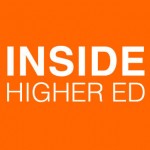The following is an August 2017 post that I wrote for Inside Higher Ed’s Call to Action marketing and communications blog.
 In The Inevitable: Understanding the 12 Technological Forces That Will Shape Our Future, author Kevin Kelly envisions a day when “the buildings we pass along the highway are screens themselves. They usually show advertisements that are aimed only at me, since they can custom focus images that only I see; other commuters see different images on the same screen.”
In The Inevitable: Understanding the 12 Technological Forces That Will Shape Our Future, author Kevin Kelly envisions a day when “the buildings we pass along the highway are screens themselves. They usually show advertisements that are aimed only at me, since they can custom focus images that only I see; other commuters see different images on the same screen.”
While the thought-provoking book takes an optimistic tone, Kelly’s prediction on this point is somewhat discouraging. We are already exposed to thousands of brand messages each day, and advances in technology are only going to produce more ways to deliver advertising. More ads, more noise.
(As an aside, we read The Inevitable last academic year, as well as Originals: How Non-Conformists Move the World, as part of a book club that I organize for marketers on our campus. In a recent post, Paul Redfern advocated for investing in professional development, and it’s important to stress that books are both a basic and essential part of one’s professional development.)
According to Educational Marketing Group and Kantar Media, estimated advertising expenditures in higher ed grew by 22% from 2013 to 2016.
Heightened competition is among the chief reasons for the advertising arms race, as institutions vie for students in a shrinking pool. During that same period, overall postsecondary enrollment decreased by 4%. The surge in online education is another factor. Options continue to expand, and public and private nonprofit institutions – which accounted for all of the 2013-16 growth in ad spend – are more aggressively seeking to gain market share.
Not surprisingly, our sector allocates more ad dollars to online media than to any other media platform. Paid digital allows us to more precisely target our audiences, and an array of metrics gives us the ability to track performance (although we must constantly ask ourselves if we’re measuring what matters). The newly released 2017 E-Expectations survey findings of college-bound families show that high school students are receptive to digital advertising and do in fact interact with ads.
Advertising should be a critical part of your overall marketing mix, but does the significant increase in higher ed advertising expenditures signal that we’re expecting our advertising to do too much?
As we feel the pressure to keep up with our competitors’ spending, Jeff Rosenblum’s advice in Friction: Passion Brands in the Age of Disruption rings true. Great brands are built, not bought.
Outspending the competition on advertising is not a viable strategy. His model focuses on empowerment over interruptions. As marketers representing the voice of those we’re trying to reach, influence, and move to action, we need to create meaning and value. Advertising no longer has to carry the entire message, Rosenblum explains; it is simply a “key piece of a connected experience,” providing a gateway to content and experiences that empower your audience. Ensure that the other components of this connected experience are adequately resourced.
One last consideration: in decentralized environments, the majority of marketing spends occur outside of the university’s central marketing effort. Most universities don’t know their total marketing investment (including advertising spend) across the entire institution and are unable to track marketing expenditures at the school/unit level. Through enhanced coordination and integration, we must maximize opportunities to drive effectiveness and efficiency and make our current advertising dollars work harder for the institution.




